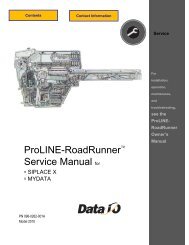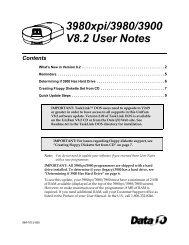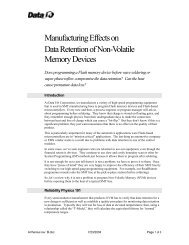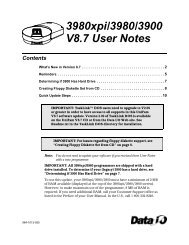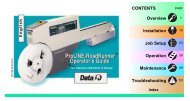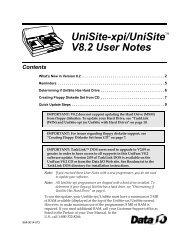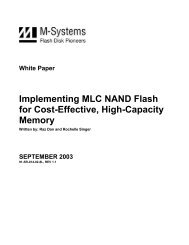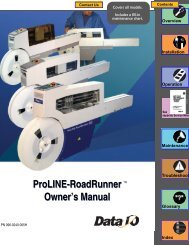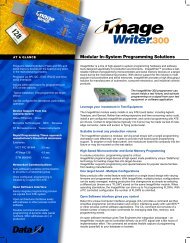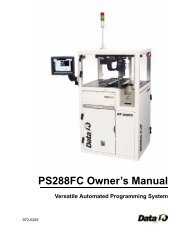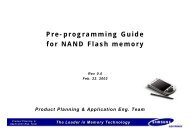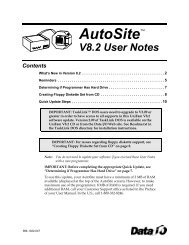Optimizing a Flash Media Manager for NAND Flash Imaging
Optimizing a Flash Media Manager for NAND Flash Imaging
Optimizing a Flash Media Manager for NAND Flash Imaging
Create successful ePaper yourself
Turn your PDF publications into a flip-book with our unique Google optimized e-Paper software.
Tel: 1-800-221-6630Email: sales@datalight.comwww.datalight.com<strong>Optimizing</strong> a <strong>Flash</strong> <strong>Media</strong> <strong>Manager</strong> <strong>for</strong> <strong>NAND</strong> <strong>Flash</strong> <strong>Imaging</strong>While the process of preparing and writing images to NOR flash is a straight-<strong>for</strong>wardimplementation, creating images <strong>for</strong> <strong>NAND</strong> is much more complex, making a uni<strong>for</strong>mprogramming strategy arduous without the proper flash media management tools. Under thecrunch of a product development schedule, it may seem practical to use a hardware simulator tocapture an image of a file system, and then write that image to new flash by reading only a part ofthe flash that is thought to include all of the files. <strong>Flash</strong> experts would tell you that this is not assimple as it sounds, and is not likely to work reliably.This paper explores the use of tools within the Datalight <strong>Flash</strong>FX Pro flash media manager <strong>for</strong>creating a flash image and initializing fresh <strong>NAND</strong> flash from this image. We also discuss bestpractices <strong>for</strong> high volume production programming of <strong>NAND</strong> flash.BACKGROUND ON FLASHFX PRO<strong>Flash</strong>FX Pro has three distinct levels of <strong>for</strong>matting used on the flash: (1) BBM (bad blockmanagement), (2) VBF (variable block <strong>for</strong>mat), and (3) the file system. Each of these has its ownfunction and imposes different constraints.Bad Block Management (BBM)BBM is Datalight's method of working around the bad blocks that are generally present in <strong>NAND</strong>flash. Even a brand new flash chip from the manufacturer may have some erase blocks that do notmeet specifications <strong>for</strong> reliable data storage, and further blocks may go bad after extended use.BBM is responsible <strong>for</strong> allocating replacement blocks and remapping addresses from bad blocksto their corresponding replacement blocks.BBM <strong>for</strong>matting must be done be<strong>for</strong>e any use of <strong>NAND</strong> flash by <strong>Flash</strong>FX Pro. Formattingconsists of allocating space <strong>for</strong> replacement blocks, scanning <strong>for</strong> factory bad blocks, and addingthem to the bad block map. After this has been done, BBM reports a size that is slightly smallerthan the full size of the flash chip. This smaller size is all that is visible to higher levels ofsoftware.For high volume production, the BBM <strong>for</strong>matting is done by production programming equipment.It is essential that the programming equipment <strong>for</strong>mats the <strong>NAND</strong> flash device exactly the sameas <strong>Flash</strong>FX Pro, so that the file system will function properly. For this reason, Datalight partnerswith Data I/O Corporation and ensures that Data I/O’s programming equipment correctly <strong>for</strong>mats<strong>NAND</strong> flash <strong>for</strong> <strong>Flash</strong>FX Pro.
<strong>Optimizing</strong> a <strong>Flash</strong> <strong>Media</strong> <strong>Manager</strong> <strong>for</strong> <strong>NAND</strong> <strong>Flash</strong> <strong>Imaging</strong> 2Variable Block Format (VBF)VBF is Datalight's method of managing the allocation of flash to provide two essential features:small block emulation and wear leveling. File systems are designed to work on disk drives thatcan be written in small increments called sectors (typically 512 bytes), and can be rewrittenrepeatedly without affecting other data or decreasing the reliability of the disk. <strong>Flash</strong> memory isnot directly usable by most file systems, as it must be erased in large increments called eraseblocks (typically tens to hundreds of Kbytes) be<strong>for</strong>e being written, and each erase cycle causeswear that ultimately results in the failure of that erase block (typically after more than 100,000cycles).VBF overcomes these limitations of flash memory by storing data in flash memory at the nextavailable location and building a map of where each allocation block (simulated disk sector) islocated in the flash. A file system may write repeatedly to the same sector address, but VBF willstore the data at a different location each time, marking the old copy invalid ("discarding" theallocation) after the new copy is written. Eventually the space occupied by the discarded data isreclaimed and erased <strong>for</strong> reuse. VBF tracks how many times each erase unit has been erased, andoccasionally relocates static data from an infrequently erased unit to a unit that has been erasedmore frequently.VBF <strong>for</strong>matting involves writing an erase unit header (EUH) to each erase unit of the area offlash managed by VBF. Each time <strong>Flash</strong>FX Pro starts up, it reads the EUHs and associatedallocation tables to build its map of what is where in the flash.In production, it is necessary that the programming equipment does the initial VBF <strong>for</strong>matting sothat the image file can be properly written to the <strong>NAND</strong> device during the programming process.The File SystemFile system <strong>for</strong>matting creates the initial data structures <strong>for</strong> a file system. Though <strong>Flash</strong>FX Procan effectively communicate with any file system, the Datalight Reliance transactional filesystem is recommended to be used with <strong>Flash</strong>FX Pro to achieve optimum device per<strong>for</strong>mance.Every file system has its own way of organizing files and directories. Reading and writing only aportion of a file system makes risky assumptions about where the file system stores its data on thedisk.When working with a FAT file system, its File Allocation Table and root directory are fixed datastructures that are guaranteed to be stored near the beginning of the disk. However, file data andsubdirectories can be stored anywhere. While it is common <strong>for</strong> FAT file system implementationsto start allocating space <strong>for</strong> new files near the beginning of the disk, as files are created anddeleted they have a potential to end up anywhere, not just at the beginning. Thus there is noguarantee that reading only the beginning of the disk up to the total size of the files (plus somesafety margin) will actually capture all of the desired data.
<strong>Optimizing</strong> a <strong>Flash</strong> <strong>Media</strong> <strong>Manager</strong> <strong>for</strong> <strong>NAND</strong> <strong>Flash</strong> <strong>Imaging</strong> 3Boot LoaderEmbedded ApplicationFile SystemOperating SystemFX LoaderDevice Driver LogicVBFOE ServicesBBM<strong>Flash</strong>FX ® ProFMSLFIMProjectHooksCPU Layer<strong>Flash</strong> MemoryOEM Hardware Plat<strong>for</strong>mFigure 1: Datalight <strong>Flash</strong>FX Pro Block DiagramCREATING AND WRITING AN IMAGE TO FLASHFor low volume applications, <strong>Flash</strong>FX Pro can be used to write an image to a <strong>NAND</strong> flash device“in-system”; <strong>for</strong> example, the image can be written to a <strong>NAND</strong> flash device in a new phoneduring development. For high volume applications, the <strong>NAND</strong> flash device is usually processedby high volume automated programming equipment be<strong>for</strong>e being soldered onto the PCB.However, in this case, <strong>Flash</strong>FX Pro is still needed to create the image by reading from the <strong>NAND</strong>flash in a development system, <strong>for</strong> example.First, we will discuss using <strong>Flash</strong>FX Pro <strong>for</strong> low volume reading and writing. <strong>Flash</strong>FX Propresents the flash as a simulated hard drive at the block device driver level. Capturing this “harddrive” image, and using it to initialize fresh flash, is unreliable as BBM, VBF and the file system<strong>for</strong>mats are not accounted <strong>for</strong> in this image. All of these data structures are required as <strong>Flash</strong>FXPro does not necessarily do all of its writing near the beginning of the flash, even when it isfreshly initialized.In order to capture the entire <strong>Flash</strong>FX Pro <strong>for</strong>mat, the functions to be used are oemread (to readthe image) and oemwrite (to write it to fresh flash). Using this method, the image is guaranteedto work between devices whose flash arrays are similarly defined. The BBM reserved area willbe created at the same location and size on the destination, as it was on the source. Anydifferences in bad blocks between the two physical flash arrays are handled transparently.
<strong>Optimizing</strong> a <strong>Flash</strong> <strong>Media</strong> <strong>Manager</strong> <strong>for</strong> <strong>NAND</strong> <strong>Flash</strong> <strong>Imaging</strong> 4Creating the ImageIn summary, creating the image should be per<strong>for</strong>med by linearly reading the raw sectors + the 16-byte spare area. These steps are as follows:• Format the flash with the flash media manager and create the appropriate file system.• Populate the file system with the desired files.• Repeatedly compact the flash until the compaction function (vbfcompact, in <strong>Flash</strong>FXPro) returns FALSE, indicating that nothing remains to be compacted.• Obtain the size of the accessible region of the flash. (Note that this size does not includethe BBM region; this region will be recreated automatically by <strong>Flash</strong>FX Pro on thenew flash.)• For each <strong>NAND</strong> page, call oemread (or similar function) and set it to read a total of 516bytes (512 bytes of user data plus four bytes of VBF allocation in<strong>for</strong>mation). Write thisdata to the image file. Do not per<strong>for</strong>m any file system operations on the flash drive whilethe image is being created.Writing the Image and Initializing Fresh <strong>Flash</strong>Initializing fresh flash from the image file (as created above) should be per<strong>for</strong>med more or less asfollows with <strong>Flash</strong>FX Pro:• Per<strong>for</strong>m initial BBM <strong>for</strong>matting. (There is no need to per<strong>for</strong>m VBF <strong>for</strong>matting, as theimage contains the VBF <strong>for</strong>mat in<strong>for</strong>mation).• Obtain the size of the flash.• For each <strong>NAND</strong> page, read 516 bytes from the image file. Examine the data: if it is allones, simply skip to the next page of flash without writing. Otherwise write it to the nextpage of flash using oemwrite. BBM will handle any bad blocks encountered during thisprocess. Since much of the image file will contain pages that are all ones, it could becompressed using simple run-length encoding or some other scheme to avoid storing data<strong>for</strong> pages that are in their erased state.• The size of the file should match the size of the flash.• After the image has been written, mount the file system.Next, we will discuss high-volume duplication or programming of the image into new <strong>NAND</strong>flash devices. Once the application is validated and a final image is created with the processmentioned above, the image is typically checked into configuration management. The processthat we describe below assumes that the factory is using Data I/O’s RoadRunner programmingequipment. The RoadRunner is an “on-line” programmer that mounts directly to an SMT feederbank and programs the <strong>NAND</strong> flash devices on the SMT line. (This process avoids risk of havingan inventory of pre-programmed flash devices in an application where frequent image (or code)changes occur.) We also assume that the manufacturing floor is using Data I/O’s TaskLink ®software application to create the “task” <strong>for</strong> the programming equipment. Here, a “task” refers tothe binary file that contains instructions <strong>for</strong> the programming equipment, as well as the masterimage.
<strong>Optimizing</strong> a <strong>Flash</strong> <strong>Media</strong> <strong>Manager</strong> <strong>for</strong> <strong>NAND</strong> <strong>Flash</strong> <strong>Imaging</strong> 5The process is as follows:• Check the image out of configuration management.• Start the TaskLink application and create a new “task”.• In the Task Edit dialog box, select the <strong>NAND</strong> flash device from the list of supporteddevices.• Selecting any <strong>NAND</strong> flash device, will automatically invoke the Special Features dialogbox; select a bad block handling type from the drop down list shown in Figure 2 below.For <strong>Flash</strong>FX Pro, use the bad-block method called “Skip Customer 1” as shown.Figure 2: TaskLink Special Feature dialog box.• In the Data dialog box, select the master image (from configuration management).• The last step is to “Create” a new task and download it to the PCMCIA card <strong>for</strong> insertioninto the RoadRunner on the SMT line.




